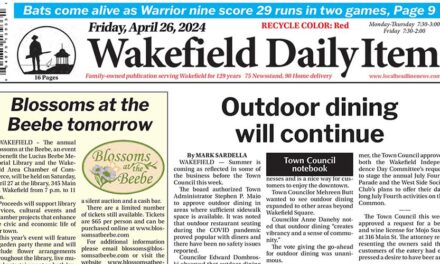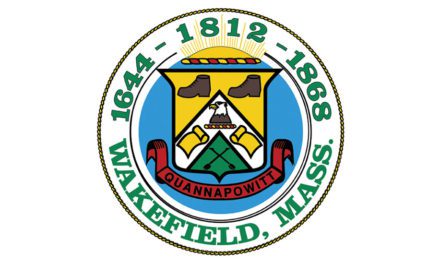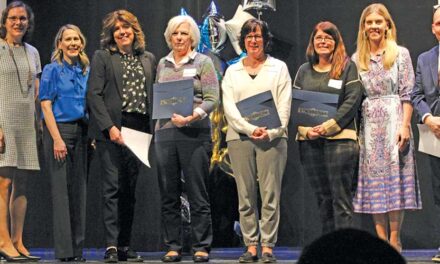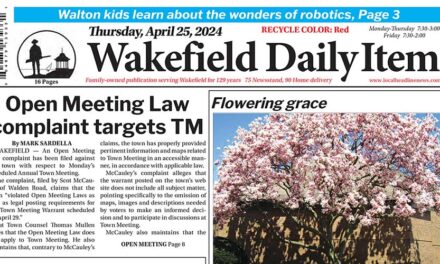Published June 19, 2019
By MARK SARDELLA
WAKEFIELD — The fourth in a series of “Envision Wakefield” public forums drew about 50 residents to the Americal Civic Center last night for an update and a question and answer session on the planned $15 million infrastructure and revitalization project for the downtown area.
The stated goal of the downtown revitalization initiative is to “conceptualize improved multimodal transportation and accessibility, enhance aesthetics and develop a unique identity for the town.”
Two different Town Meetings have appropriated a combined $821,500 for Phases 1 and 2 of a design process that is expected to result in over $15 million in federal funding administered by the Massachusetts Department of Transportation (MassDOT) for the project.
Town Councilor Edward Dombroski, who has taken a lead role in spearheading the project, reminded those in attendance that the town has retained the engineering/design firm VHB to create the design for the project, based on direction from the town.
Dombroski stressed that it continues to be a work in progress and that public forums like the four that have already been held continue to play an important role in guiding the design process.
He said that safety was a major focus of the project along with parking. He cited moving from angle to parallel parking and shortening crosswalk distances as two measures designed to improve safety.
Dombroski addressed questions that have been raised about bicycle lanes by noting that bike lanes are likely to be a requirement in order to get the MassDOT funding for the project.
Dombroski turned the presentation over to Geoffrey Morrison Logan, Patricia Domigan and Elsa Chan from VHB.
Logan stressed that the design process was still in its early stages as he reviewed some of the measures that could be taken to improve safety and minimize car accidents in the downtown area.
A series of five videos were then shown that reviewed the proposed changes in various sections of the downtown. The videos were created by Jennifer McDonald, the town’s Communications director. After each video was shown, questions from the audience were entertained.
Jim Scott of Elm Street said that it seemed to him that the bike lanes in the center of town were duplicating the future bike trail along an abandoned rail bed a short distance from the downtown.
Domigan responded that the federal funding mandates that multimodal transportation must be part of the project.
Another resident asserted that the funding was what was driving the bike lanes, not any current or projected need for them.
But David Knudson of Eaton Street said that in Boston, the addition of bike lanes has resulted in an increase in bike ridership. Another resident said that when bike lanes were added in Lexington, cyclists came from a nearby bike trail to patronize local businesses.
Dan Benjamin of Foster Street wanted to know what impact new features like bike lanes would have on snow removal in the downtown.
DPW Director Rick Stinson said that it wouldn’t change anything. “It’s the same amount of snow,” he said, adding that “It shouldn’t be an issue.”
Another resident was concerned about the loss of local control over the project. She said that people don’t realize the degree to which the state will decide where things can go and where they cannot. She also worried that bringing in more bike riders to the downtown would lead to more obstacles on the sidewalks.
Julie Scott asked if the bike lanes could be shifted from the downtown area to Crescent Street. Domigan replied that that was one idea that was being pursued in discussions with MassDOT.
Several residents expressed concern that widening Lake Avenue to enhance parking on that street would encroach upon the grass on the Common.
There were fewer questions when it came to the Albion Street and Water Street aspects of the project.
Domigan discussed the next steps in the project, which will include continuing to meet with focus groups and town staff, meeting with MassDOT, finalizing the traffic and parking analysis and applying to MassDOT for funding.
Other future considerations include designing drainage and other utility needs, submitting 25 percent design plans to the town for review and approval followed by submission to MassDOT.




